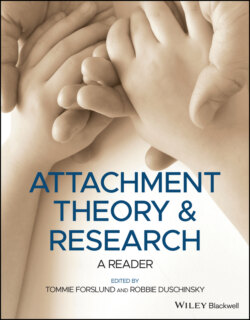Читать книгу Attachment Theory and Research - Группа авторов - Страница 30
Fear and Anxiety, Conscious and Unconscious
ОглавлениеIn the account of fear and anxiety sketched several elements are distinguished. They can be arranged in two sequences according to whether disturbance of homeostasis is appraised as actual or only threatened. Because threats of disturbance are much commoner than actual disturbance, and also as a rule precede actual disturbance, the sequence resulting from threat is presented first.
1 Disturbance appraised as threatened
1 Statistical likelihood of disturbance occurring in any of several categories of homeostasis, the likelihood in each case being detectable either from stimuli arising from the actual presence of a potential stressor or from stimuli arising from an indicator correlated with a probable presence of a potential stressor;
2 Appraisal of such stimuli as warning signals or signals of threat;
3 Preparatory responses that have the effect of preparing an individual to take any of a great variety of actions, including those preventive or corrective of disturbance;
4 Avoiding actions that commonly have the effect of preventing actual disturbance, but that may fail;
5 Continuous monitoring both of threat and of any changes occurring in its degree of imminence, and also of the effects of preventive actions;
6 Continuous estimating of the degree of success in preventing disturbance likely to be achieved by preventive actions, or by plans for preventive action;
7 In the light of such estimates, the revision, if necessary repeated, of plans for preventive action.
1 Disturbance appraised as actual
1 Actual disturbance occurring in any of several categories of homeostasis, the disturbance in each case being caused by the action of a stressor and itself constituting a stress of some kind and degree;
2 Indicators of disturbance (stress), some of which act automatically in eliciting preparatory and/or corrective actions and some of which come into being as indicators only after ‘raw’ stimuli have been appraised as indicative of stress;
3 Preparatory responses that have the effect of preparing an individual to take any of great variety of actions, including corrective actions;
4 Corrective actions that usually have the effect of cancelling disturbance and restoring homeostasis, but that may fail;
5 Continuous monitoring both of disturbance and of any changes occurring in it and also of the effects of corrective actions;
6 Continuous estimating of the degree of success in restoring homeostasis likely to be achieved by corrective actions, or by plans for corrective actions;
7 In the light of such estimates, the revision, if necessary repeated, of plans for corrective actions.
It is probably wise to assume that any of the components in either sequence, when present, can either be conscious and felt or can remain unconscious and unfelt. What this statement implies is that every element in a sequence may be conscious and felt, or that no element in a sequence may be conscious and felt, or that any one or more elements may be conscious and felt and that others remain unconscious and unfelt.
To illustrate some of the clinical conditions that call for explanation it may be useful to give a few typical examples of people responding to disturbance, or threat of disturbance, without being fully aware of what is going on. A number of different patterns are well known to occur in patients before a holiday break. Patient A may be aware of anxiety but fail to relate it to the impending break and instead attribute it to something quite different. Patient B, by contrast, may show no overt anxiety, nor feel any, yet show by his actions that threat of disturbance has been appraised and appraised correctly: he may become remote, have little to say and may even miss the last session. Patient C may claim to be feeling no anxiety nor to have cause for any, yet be surprised to find himself tense and sweaty. Patient D may claim that he was never informed that a break was impending.
The assumption that any one or several elements in the sequences listed can be conscious and felt or unconscious and unfelt is in keeping with clinical experience. Taken in conjunction with knowledge that the appraisal processes involved vary from individual to individual, and also for any one individual on different occasions, and in addition may be of any degree of accuracy or inaccuracy, this assumption (and the schema of which it is based) might be expected to provide sufficient parameters to account for the great variety of psychological states, met with in and out of clinic, that are at present described in terms of anxiety, either conscious or unconscious, and of defences against anxiety. Whether or not that expectation is fulfilled requires extensive examination of the data.
